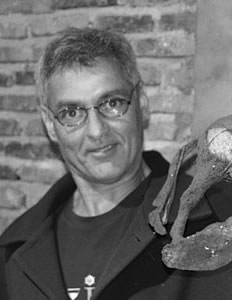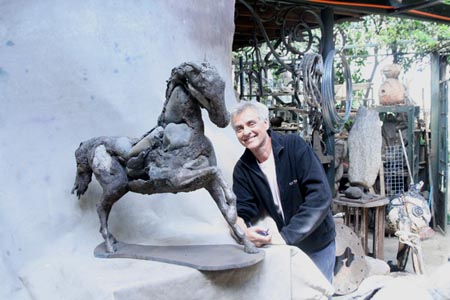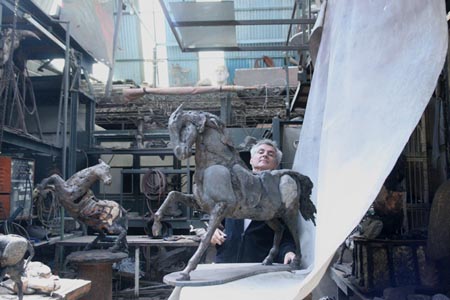 home
about
artists
exhibitions
press
contact
purchase
home
about
artists
exhibitions
press
contact
purchase |
|||
|
Pedro Pablo Valdés Bunster, well-known as Palolo Valdés, was born in
Santiago, Chile on the 1st July 1956. He is a sculptor and painter.
He has carried out three individual exhibitions of painting and
twenty of sculpture in Santiago, New York, Paris, Athens and Madrid.
He is an author of twenty monumental works for public and
institutional spaces in Chile, Bolivia, Uruguay, United States and
Madrid.
Shanghai Art Museum, China, 14/02/2007-28/02/2007
The works are skins soaked in the environment, in the spirit of their
times. Arranging them has a double purpose: to string these pieces
together and put them in the historical loom, knowing what it was, what
it is... to glimpse what is coming.
Different fruits from the same tree in the workshop have been picked up
and, in order to arrange them somehow, they are presented here as
blocks, as series.
When I was not a boy or an adult, the life full of trophies - a dry
leaf, a copy book, a kiss, lots of adventures that filled my pockets in
the evenings - needed a table to empty them, a proper space that also
guaranteed my arrogant independence.
Shaping and painting was a licence to live.
Picking up a piece of clay, hitting it and kneading it, stretching and
shrinking, submitting it to the edge of a determined shape; or, drawing
the space with wire, making a stone spin on a board, compose it with
another one, in harmonic counterpoints being the spectator of a lot of
possible shapes until defining one, among multiple interpretations, but
one at last. The one chosen is frozen with liquid metals, it is
considered done and it is seen off. It is a trip. I am the vehicle. I
prepare the road and decide where to go. I work. I govern. I work... I
am the King of my life... liked that!
Not everything is rose-coloured and to see its colour and soft petals,
there are its black and prickly branches.
Life is a harmony of contrasts. From the warm and dark uterus' humidity
to the light's dry scream. Years have gone by in the workshop among ups
and downs.
More than new shapes or "modern" conceptual approaches, they are ways of
doing, ways of facing a physical and specific issue, looking for the
shortest way with elements to hand. These are found without looking for
them, not by chance, but by causality.
Just like springtime comes after winter every year, in the daily work
ideas are born in the act and they are threaded in spirals, directed by
the self criticism sense that comes after what was lived and with the
work; the skill.
The current work comes after the sum of the above. The topic, usually
distant, is secondary, insisting in certain shapes.
As daily exercises that make and develop a body, an individual vision. A
way of making that implies a way of being; to study until the chance to
do something comes or for the biggest event in my life, death.
PALOLO VALDES BUNSTER
The painters of the caves at Lascaux knew how to project and produce
representations of their models, how to take advantage of the rough,
irregular surface of the walls to execute their remarkable drawings.
They employed a variety of earth tones on the chalky surface of the
Perigord rock, achieving a surprisingly balanced synthesis in their
imagery. The result remains astounding. Conscious of tradition,
Palolo is one of the few artists today who does not revel in his own
creativity. He is the humble heir of traditions that not only
originated in Europe, but also in primitive cultures all over the
world, stretching back in time to Lascaux and its iconic animals.
Being aware that one is just a tiny link in an endless chain permits
Palolo to dedicate more energy to structuring his work than to
contriving its imagery. It is in the field of combining stone, metal
and clay — all elements common to art history — that he contributes
to the restless tides of universal culture. He renews our vision,
for example, of the horse and the bull through an unprejudiced
rapport with his materials. In his work, he makes us feel that the
animals of Lascaux have come back to life, pawing and prancing, once
more beholders of the power and fervour that pervade all life. It is
the renovation of this legacy that gives Palolo's vocation and his
work its significance. Palolo is already an
internationally-recognized artist: his sculptures have received warm
receptions in major Old World cities, such as Athens, Madrid,
Brussels and Paris, in addition to those in his native Chile. His
work speaks a universal language: he touches themes common to all
times, using commonplace materials. His objective is to give a new
twist to certain images that art history has chosen to venerate.
This book summarizes his career, records his motivations and
registers the development of his work. It takes us to the gateway of
his next step: a retrospective exhibition in China. This project
presents a new challenge, since the artist has sought his imagery in
the masterpieces of Western art and, until now, has always shown the
results of this search in European or South American cities.
He is taking an important cross-section of his work to Shanghai. His
trip evokes the spirit of an old English saying, like a bull in a
China shop, or of a gigantic breaking wave ready to be absorbed by
the porous sand of a receptive beach. Palolo in China is a master
class in cultural shock, in meshing opposites. This artist's work is
pure enthusiasm, brimming with passion and action. Chinese art is
another story, filled with another essence. His
foundational works are horses, his icon for individuality, and
bulls, that beast of blood and sperm that is pure instinct and
animal energy. Palolo, nevertheless, fabricates his bulls in metal
and stone instead of flesh and bone or paint and canvas. He devises
a style of his own, with abrupt gestures and erratic movements. His
art is vital, voracious, volcanic. The works erupt like lava, in its
irrepressible outward flow. Nothing detains his hand when
inspiration sets it in action. In spite of the frenzy at the moment
of execution, the artist, nevertheless, is capable of moving like a
cat in the delicate environment of a distant and unknown habitat.
Let us continue with the metaphor of opposing poles: East-West.
What a contrast to the millenary codes of the Orientals, fortified
by the deliberate march of centuries of reflection and
contemplation. Porcelain and rice paper, refinement, suggestion,
moderation, ceremony are all terms that are inappropriate to
describe this artist's approach. How important these contrasts are:
how timely these opportunities to confront contradictory attitudes,
conflicting visions. Palolo, pure exuberance: the Orient, refined
elegance. There is a meeting of the two in this exhibition, where
the West defines itself through its art and reveals something of its
characteristic and overt aggressiveness. But Palolo
is definitely an artist and a creature of his studio, that intense
universe he has created to nourish his creative impulse and focus
his energies. His work space is like himself, like his sculpture: a
battlefield where he and his troops, all talented, audacious,
committed youths, share the task of conjugating piles of rocks with
liquid metal and soft clay at the foundry in harmonious unison. It
sounds like the dream world of an archaic alchemist: a sanctuary
designed to convert the banal into riches, the spoiled in purity,
releasing a new element that can emit a halo of spirituality. His
works, however, are brutally physical, crude and rough at times,
products of his search for the essence, for example, of the bull or
the stallion, reinventions of Greek masterpieces or iconic
representations of the highpoints of sacred art. In this sense, the
artist considers he is an interpreter of ancient traditions more
than a creative force. His way of working does not correspond to the
customary canons of modern art. He works in the midst
of calculated disorder. The chaos, nevertheless, is more apparent
than real, more accidental than intentional, more constructive than
destructive. Obsession supersedes prudence. Immediacy comes before
caution. The method is more explosive than elaborate. Palolo, in the
inferno of his workshop, seems like a demon roasting infidels, a
demigod practicing allusive alchemy. He wants to spread his
interpretation of beauty through his own versions of perennial
masterpieces. There are reminiscences of a mechanic's garage,
something of an infernal laboratory, imbued with the spirit of a
society of young poets or flea-market fanatics. In truth, he is a
simple man with a drive to move ahead and spread his wonderings in
work, and this world that surrounds Palolo assures the perpetuation
of a work ethic, a life style, where the foreman imposes his will
and the team adapts to the explicit rules that accompany the
mercurial process. The apprentices are forged in the fire of this
special vision. Although the work may seem
spontaneous, Palolo has developed a litany of thoughts that validate
his artistic attitudes. He describes them: "The product or the work
of art is no more than a reminder, the debris of the creative act."
Or, as he points out in another essay: "The theme is almost always
distant, secondary: a cat, a horse, a bull. Something like daily
exercises that help to develop a special vision. Running at the edge
of the sea from stone to rock (advancing, aided by the different
living obstacles that destiny places in our path, running giddily in
the adventure of living, developing a spontaneous and effective
capacity to solve the most diverse problems, preparing oneself for
those important events when one has the opportunity to do
something): from rock to stone. Running the most quickly possible,
falling the least possible, taking advantage of the first and last
opportunity, my life, the maximum expression of nature, capable of
creating and also destroying." Palolo's artwork
emerges from this cerebral pressure cooker, each piece a product of
his personal premises. Many have travelled to Paris, Brussels,
Madrid or Rome, and now they are on their way to China, where, in a
pristine, contained environment, they will take on new life, new
significance, and renewed beauty. Palolo the artist emerges from his
grotesque cocoon and his work casts the spell of butterflies.
Butterflies of species unknown to this legendary and distant land: a
novice of the twenty-first century daring to show his handcrafted
work to cultures whose origins predate our collective memory, though
millennia later than that of Lascaux. His bet might
seem a risky one, but art is still art wherever it reveals its
secrets, and this artist is prepared for the adventure. The Chinese,
amidst their opening to a global future, are ready to be receptive.
It is the correct moment; the timing is propitious for this
experiment in weaving fresh understanding via new expressions in
art. Palolo has created a personal universe where he
imposes his own rules. Nothing retains its pre-established structure
within the studio. Metal turns to liquid, the teacher to student,
assistants become teachers, stone seems human and takes the forms
suggested by the artist's imagination. Team spirit spreads across
time and place, making the atmosphere one of a Renaissance artist's
workshop, in which the magic of alchemy endows a circumstantial
alloy with characteristics of balance and beauty.
Metal envelops stone like a lover in a tight embrace that aspires to
perpetuate eternity. Palolo is ceaseless dynamism: if he does not
know, he acts. If he does not know how to act, he invents. That has
led him to devise his own techniques, such as joining two transitory
liquids — clay and metal — in harmonic amalgams, transforming them
into new incarnations of archaic forms: animals and beings with
rough and fractured surfaces, charged with enduring strength. The
workshop is a centre for transfiguration where everyone contributes
— the veteran alongside the novice — to carrying out the artist's
dreams. The studio, in reality, has the attributes of an explorer's
adventure at high sea, all are conscious of the risks as well as the
rewards. The crew navigates toward uncertain destinations, the
wanderings of the intrepid: victims or victimizers of the laws of
nature? To be an artist/director of a workshop is a far cry from
conducting an orchestra or leading an army. From
another angle, the flavour of the essentials is incorporated: the
sensuality of the union of a man with his materials; the marriage of
the tactile with the visual; the requisite tension between two
inescapable dualities. In summary, our artist is intuitive,
impulsive and irreverent. His work is the result of a confrontation
with life itself. Palolo lives through his work — its realization is
achieved by the weight of his input in each piece that carries his
signature. We must fit this voyage across Palolo's
work and world into the suitcase that he will carry to the Orient.
It is an attempt to circumscribe and contain both his career as well
as the artist himself in a manageable space. Palolo does it in his
way in the texts he himself has contributed to this book. Here,
however, our intention is to do it from a close distance, nothing
like the time and space that separates us from China, from the Far
East. But, today, distances are not what they once were: much of
their burden has disappeared with jets, computers and cellular
phones. What remains of distance, in reality, is the result of man's
ignorance, lack of contact, or curiosity. This distance can manifest
itself in Chile, Europe or China. Palolo dispatches
his work in an attempt to diminish these distances, those of the
spirit, knowledge, and fear. He is an ambassador without portfolio,
from a country at the periphery, proposing a lasting liaison: he is
an artist who exhibits without explanations, who shows without
conditions. His goal is to join us together through stone, metal and
clay, the universe's most humble elements. He wants to share without
influencing, produce brotherhood without conquest, to learn without
teaching. Let is enjoy his generous contribution!
Edward Shaw PALOLO Sculptures Exhibitions (Selected) Awards
Public Sculptures
Outstanding Collections.
1956 He was born in Santiago de Chile, Chile. He’s the first sculptor in the world that can make use of these
multiple materials successfully. Exhibitions (Selected): Awards:
http://www.winternet.com/~kingman/special/latin_artists/valdes/valdes.html
I first met
Palolo when he was living in New York City in 1983. I lost touch with
him for years but contacted him on a trip to Chile in 1994. The raw
power of several of his sculptures blew me away. Palolo casts aluminium
and bronze over river rocks held together with steel armatures. The
result is a primitive looking form that appears to have been sculpted by
Vulcan himself and erupted onto the face of the earth.
Brant Kingman |
|||
|
|
|||
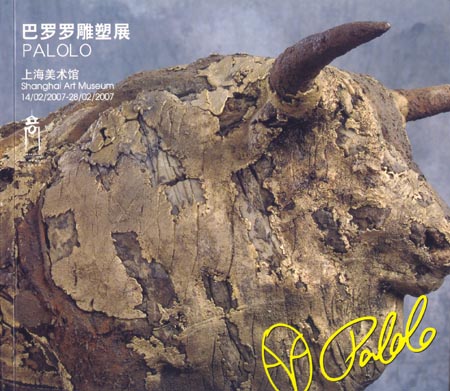 Expressing
with a handful of photos the work of so many years, is a real
selection deed. They have here an autobiographical rescue character.
More than products they are pieces of existence, ways of doing,
between objectives and resources.
Expressing
with a handful of photos the work of so many years, is a real
selection deed. They have here an autobiographical rescue character.
More than products they are pieces of existence, ways of doing,
between objectives and resources.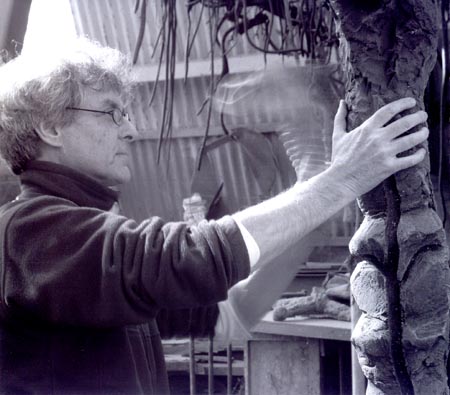 I
was filled with astonishment when I entered the cave at Lascaux and
discovered the images of bulls and stallions painted on the underground
chamber's walls by prehistoric artisans 17,000 years ago. I finally
understood how to situate Palolo Valdes Bunster in the great march of
art that originated so long ago in these remote caverns in Southern
France, now such a propitious landmark for mankind and its spiritual
survival. Palolo's work forms part of this long tradition of individual
creativity, destined to perpetuate an ongoing imprint of man's potential
on our planet. He continues to represent those two families of creatures
— bovines and equines — whose nobility was recognized and registered,
apparently for the first time, more than fifteen millennia ago.
I
was filled with astonishment when I entered the cave at Lascaux and
discovered the images of bulls and stallions painted on the underground
chamber's walls by prehistoric artisans 17,000 years ago. I finally
understood how to situate Palolo Valdes Bunster in the great march of
art that originated so long ago in these remote caverns in Southern
France, now such a propitious landmark for mankind and its spiritual
survival. Palolo's work forms part of this long tradition of individual
creativity, destined to perpetuate an ongoing imprint of man's potential
on our planet. He continues to represent those two families of creatures
— bovines and equines — whose nobility was recognized and registered,
apparently for the first time, more than fifteen millennia ago.